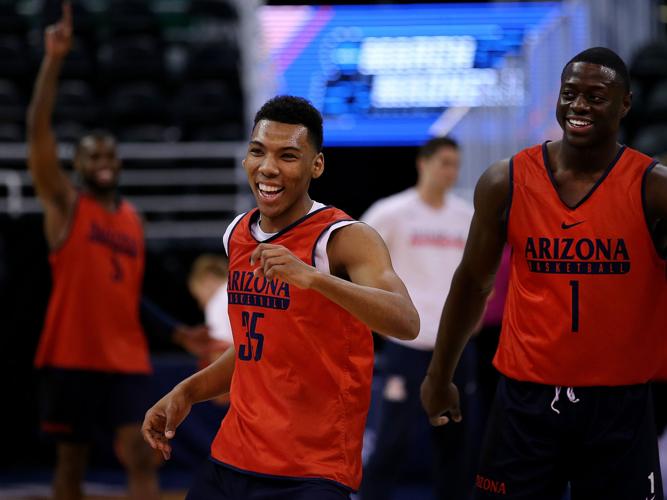SALT LAKE CITY —
The story of Arizona’s 2016-17 basketball season is two-part harmony. Chapter One is B.T. Chapter Two is A.T.
Before Trier. After Trier.
Sean Miller’s midseason addition of Allonzo Trier was the equivalent of a football coach changing quarterbacks after climbing into the Top 10, implementing a spread offense and ditching the triple-option.
Do this at your own risk.
Everything changed for every player on the court, except maybe Ol’ Reliable, senior defensive stopper Kadeem Allen.
Arizona was 17-2 when Miller broke down his team and essentially started over. That’s why the Wildcats slogged through February, struggling to put away patsies like Washington and Stanford.
“We’re a far cry from where we were in the middle of the season,” Miller said Saturday night in Las Vegas. “We went through a long period of time to find ourselves and find out what would work.”
At the time, Miller didn’t fully acknowledge the difficulty of adding a man who would become the team’s leading scorer (17.3 per game) and leader in minutes played per game (31.7). Maybe he didn’t want to panic anyone. Maybe he didn’t want an opponent to suspect the Wildcats were vulnerable.
Or maybe he just didn’t want anyone to know how delicate this face-lift would be. Can you imagine the egos involved?
Lauri Markkanen began playing closer to the basket. His 3-point attempts went from 93 before Trier, to 62 after Trier.
Rawle Alkins averaged 31 minutes per game before Trier — and 23 A.T.
The playing rotation changed. Roles for each player evolved. And yet team chemistry blossomed. Amazingly, it all came together last week at the Pac-12 Tournament.
“We went through a long period of time trying to find ourselves and find out what would work” Miller said.
I’m not sure Miller would ever publicly rate his coaching performances, season to season, but it’s difficult to imagine anything better than what he did from late January to early March. The Wildcats became a different team and more importantly, a better team.
The basketball forensics of Trier’s addition are easily diagnosed.
Trier averages 31 minutes per game. Here’s where they came from: Kobi Simmons plays 12 fewer minutes than he did B.T. Alkins plays eight fewer minutes. Dusan Ristic seven fewer. Keanu Pinder six fewer.
Everybody gave a little.
Trier attempts 10½ field goals per game. How did Arizona find 10½ shots a game for a new player? Since Trier’s return, Simmons averages three fewer shots per game; Alkins 2½ , Ristic two, Markkanen one and Pinder 1½.
Everyone gave up a piece of his game for the good of the order.
“I control what I can control and that’s it,” Alkins said Wednesday at Arizona’s final practice before the NCAA Tournament. “The bigger picture is that we are trying to win a championship, not individual honors.”
Trier’s impact is best measured in crunch time. The Wildcats played seven close games in Trier’s absence — Michigan State, Butler, Gonzaga, Texas A&M, Cal, Utah and USC. I consider the final seven minutes of close games to be crunch time. Here’s how Arizona’s point distribution went during crunch time of those games (the totals include free throws made):
Markkanen 12 shots and 28 points.
Alkins nine shots and 12 points.
Ristic eight shots and 12 points.
Simmons 11 shots and eight points.
But when Trier returned he became the UA’s go-to scorer in seven close games (against Oregon, Stanford, Washington, Cal and three UCLA games). Here’s how the point distribution of crunch time changed with Trier:
Trier 10 shots and 26 points.
Markkanen 12 shots and 22 points.
Allen five shots and 15 points.
Simmons two shots and four points.
Trier’s late-game value is as much his ability to draw fouls as anything else. He has made 16 of 19 foul shots in those games. In the seven crunch-time finishes without Trier, no Wildcat attempted more than seven free throws, the easiest points in basketball.
One thing that hasn’t gone unnoticed: Trier likes the pressure when the game gets tight.
“I love the moment,” he said Wednesday. “Some people are born with it and I’ve always felt I could rise to the occasion.”
Trier has made significant improvement from his freshman to sophomore season in defensive awareness and in not eating up the shot clock before deciding to pass. Arizona played effectively against very different zone defenses of UCLA and Oregon, and a lot of it was Trier becoming better in the clutch.
“His assists are up,” Miller said. “Our team appreciates how he has learned to pass the ball and play with others better than he ever has before.”
With Trier on the bench in a November loss to Butler, Arizona scored just eight crunch-time points and made one foul shot. Something seemed lost.
Now, 3½ months later, what UA fans feared lost has been found.





